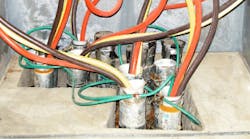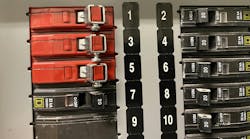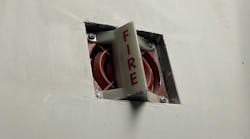Here’s your chance to moonlight as an electrical inspector and second-guess someone else’s work from the safety of your living room or office. Can you identify the Code violation(s) in this photo?
Hint: Size of bonding jumper
Find the Answer
How well do you know the Code? Think you can spot violations the original installer either ignored or couldn't identify? Here's your chance to moonlight as an electrical inspector and second-guess someone else's work from the safety of your living room or office. Can you identify the Code violation(s) in this photo?
October Winners
Our three winners this month were: Dan DeFosset, P.E., director of corporate service, ESCO Technologies, St. Louis; Robert Gerbert, Jr., associate engineer, City of Stamford, Stamford, Conn.; and Chris Adcox, superintendent, Auburn Electrical Construction Co., Auburn, Ala. The primary violation cited by these three was failure to adhere to the rules given in 314.15, Damp or Wet Locations.
The first sentence of this Code section states, “In damp or wet locations, boxes, conduit bodies, and fittings shall be placed or equipped so as to prevent moisture from entering or accumulating within the box, conduit body, or fitting.” Wrapping a plastic bag around this box is not a recognized method for satisfying this rule.
The next sentence of 314.15 says, “Boxes, conduit bodies, and fittings installed in wet locations shall be listed for use in wet locations.” Although the Code generally leaves determination of equipment acceptability up to the Authority Having Jurisdiction (AHJ), the wording in the second sentence clearly and specifically requires that only those boxes, conduit bodies, and fittings that have been tested and listed by a third-party testing lab — suitable for the application — may be used.
Another violation identified here is the missing knockout, which is a breach of the rule in 110.12(A), Unused Openings. This requirement states, “Unused openings, other than those intended for operation of equipment, those intended for mounting purposes, or those permitted as part of the design for listed equipment, shall be closed to afford protection substantially equivalent to the wall of the equipment.” In other words, a KO plug should have been provided.
‘TELL THEM WHAT THEY'VE WON…’
Using the 2008 NEC, correctly identify the Code violation(s) in this month's photo — in 200 words or less — and you could win something to put in your tool-box. E-mail your response to [email protected], and he'll select three winners (excluding manufacturers and prior winners) at random from the correct submissions. Winners will receive a set of insulated hand tools from Ideal Industries, Inc., valued at more than $125.* The set includes 9.25-in. insulated side-cutting pliers, 10-in. insulated tongue-and-groove pliers, and a 0.25-in. × 6-in. insulated screwdriver. (* Please allow six to eight weeks for delivery of tools.)





